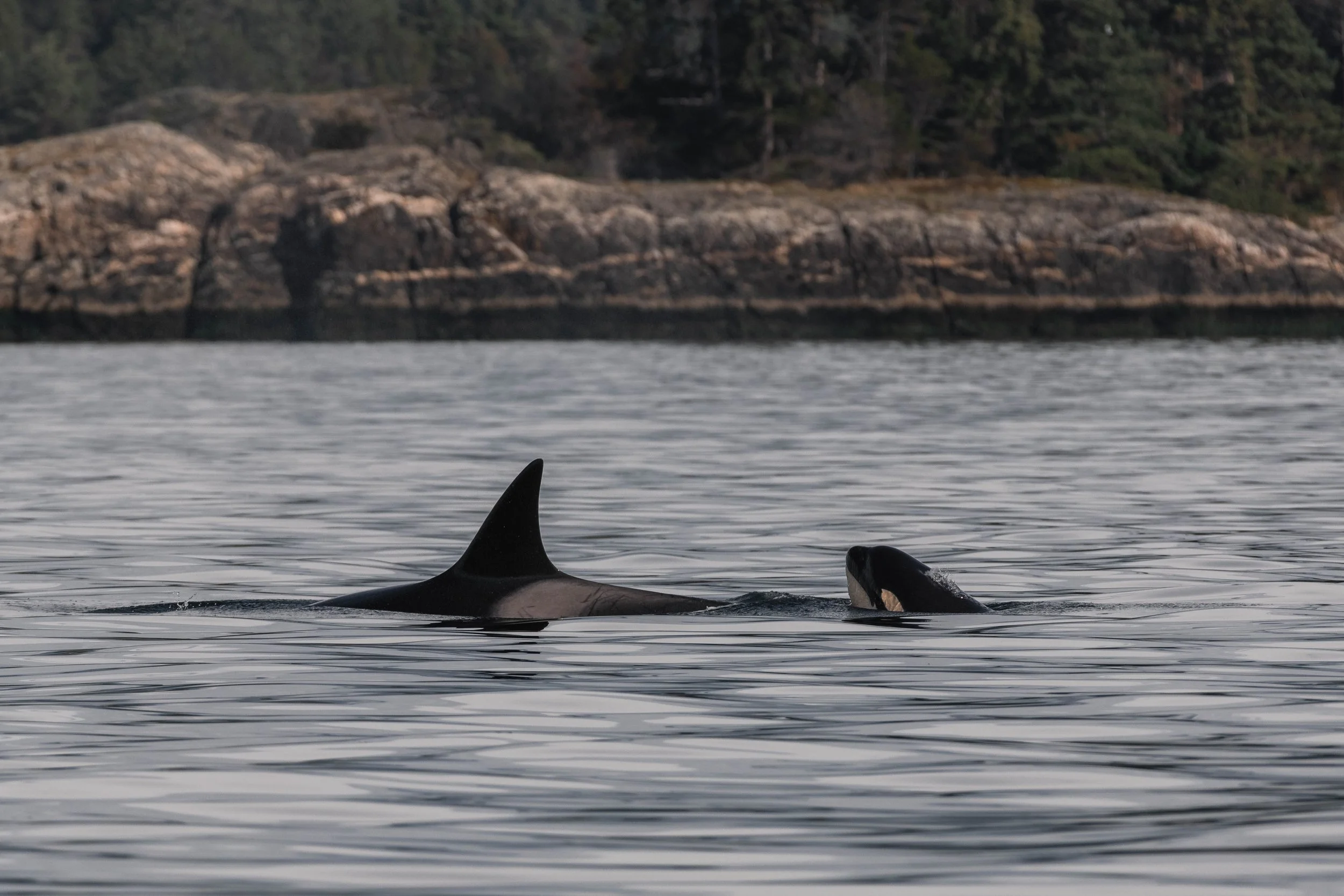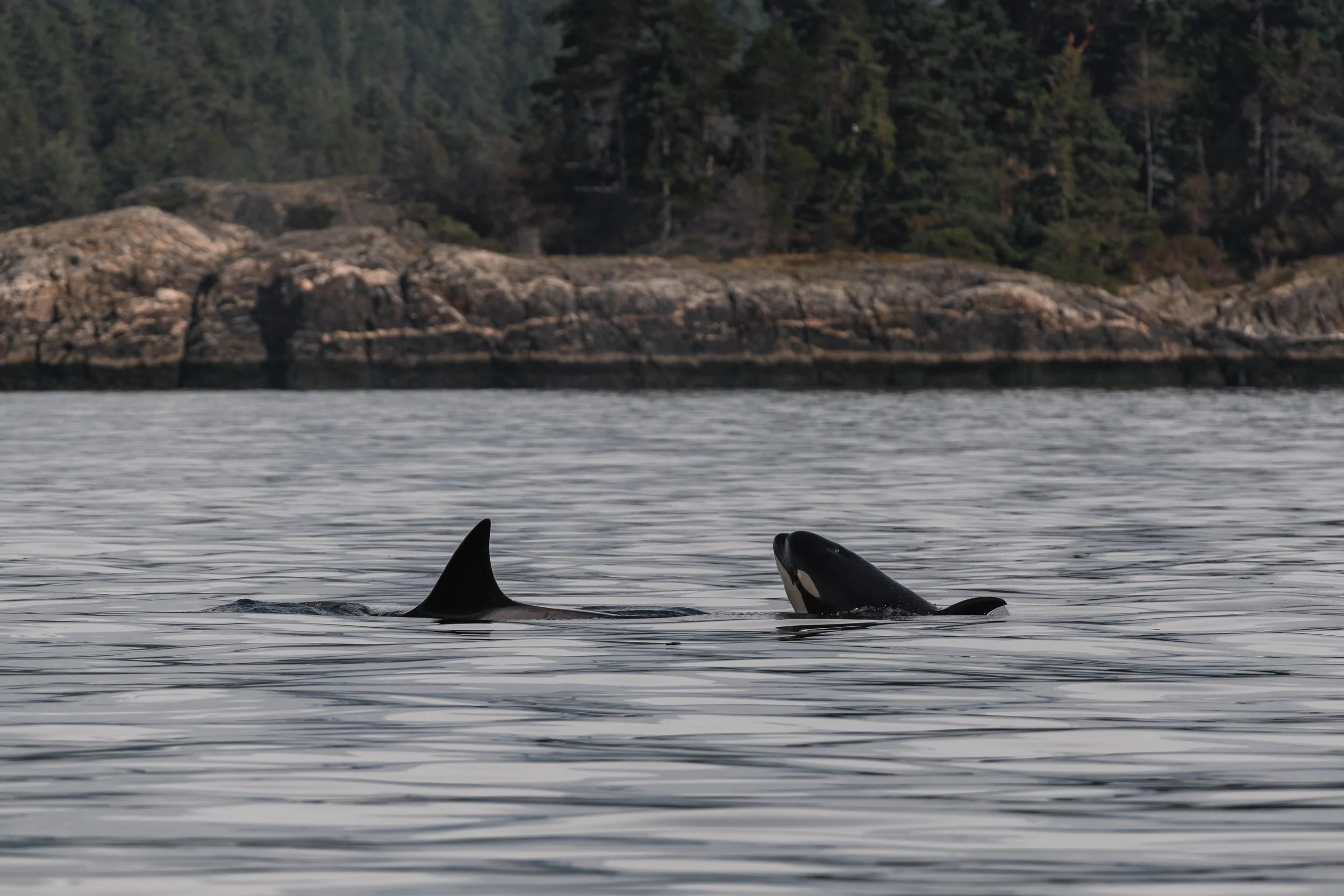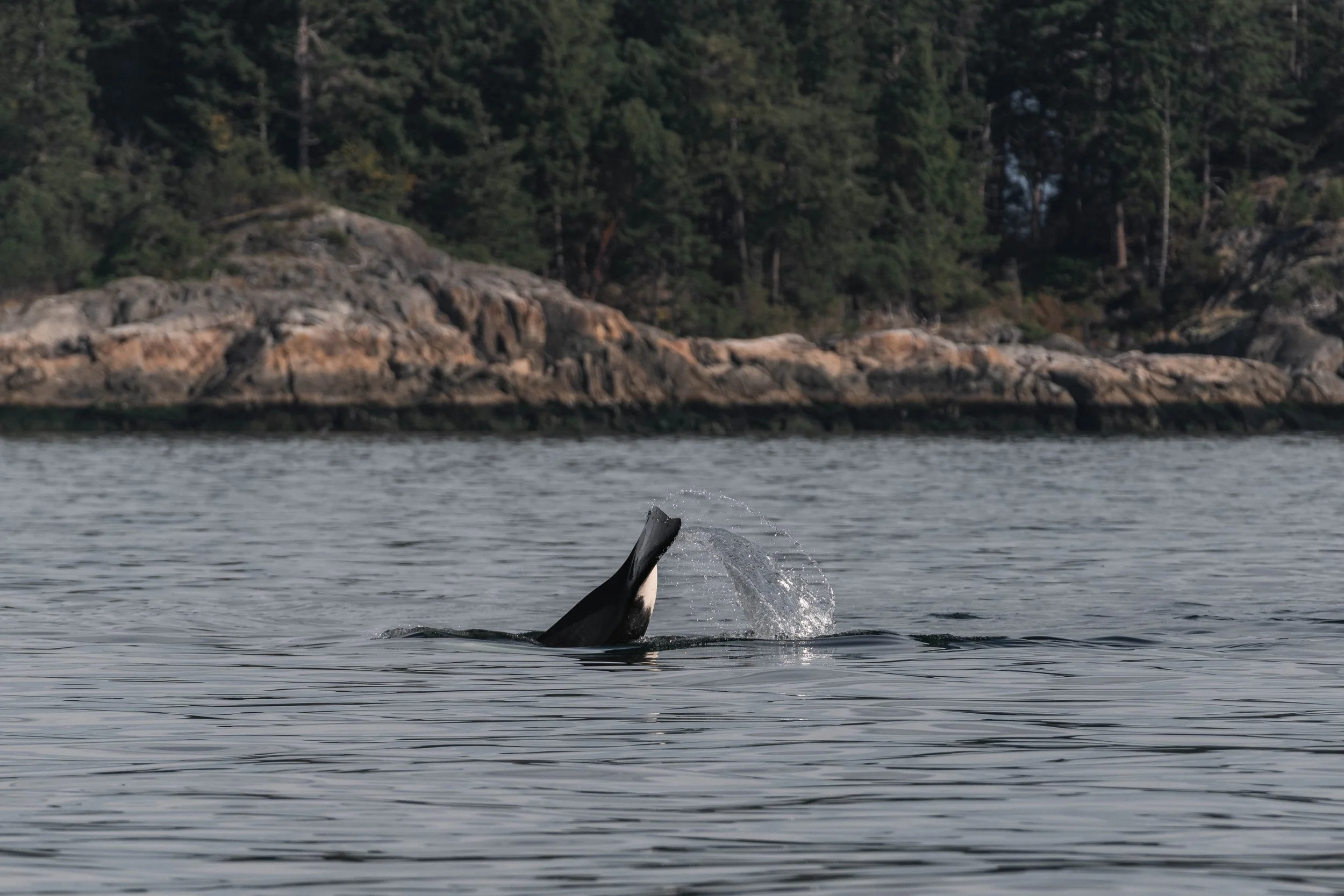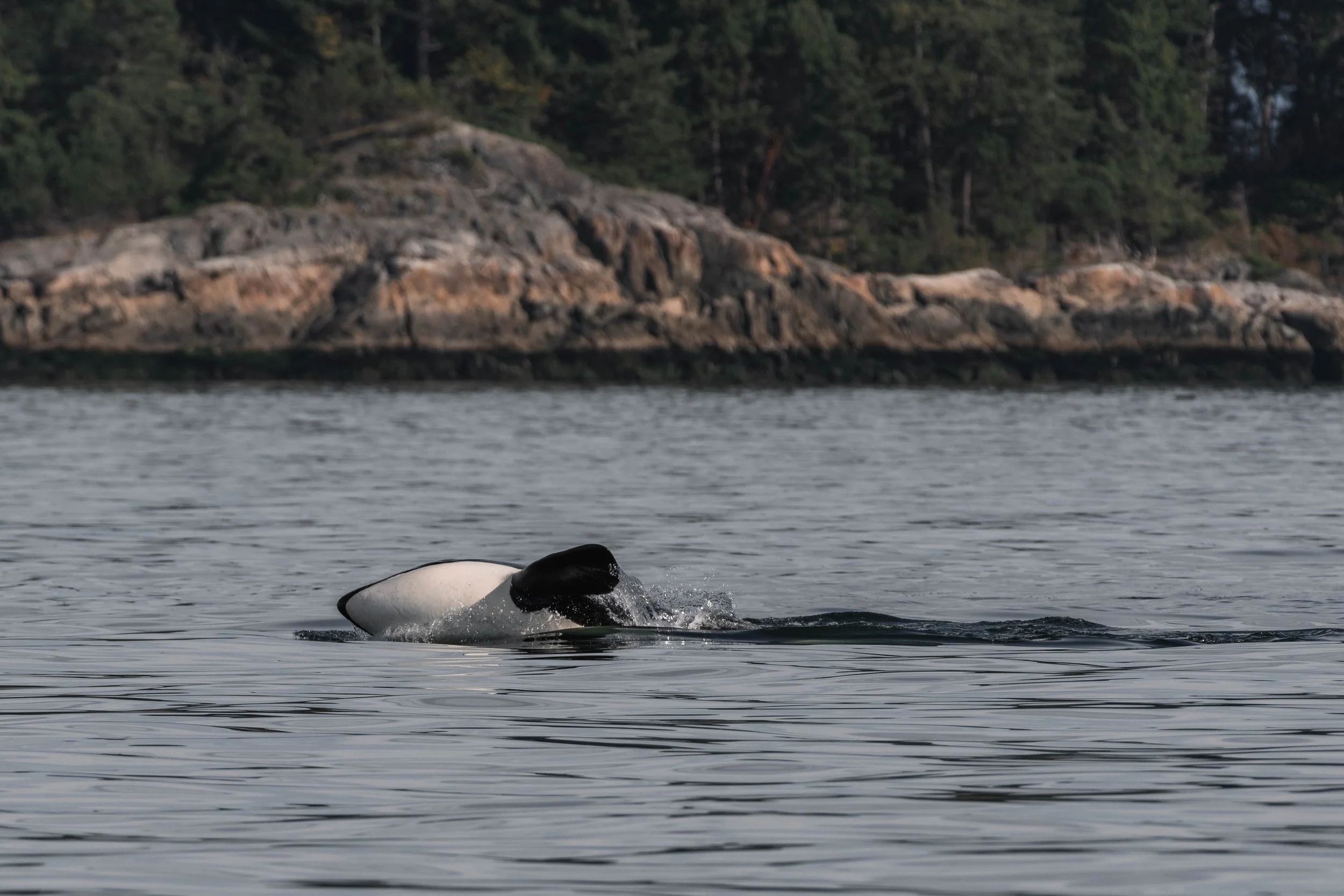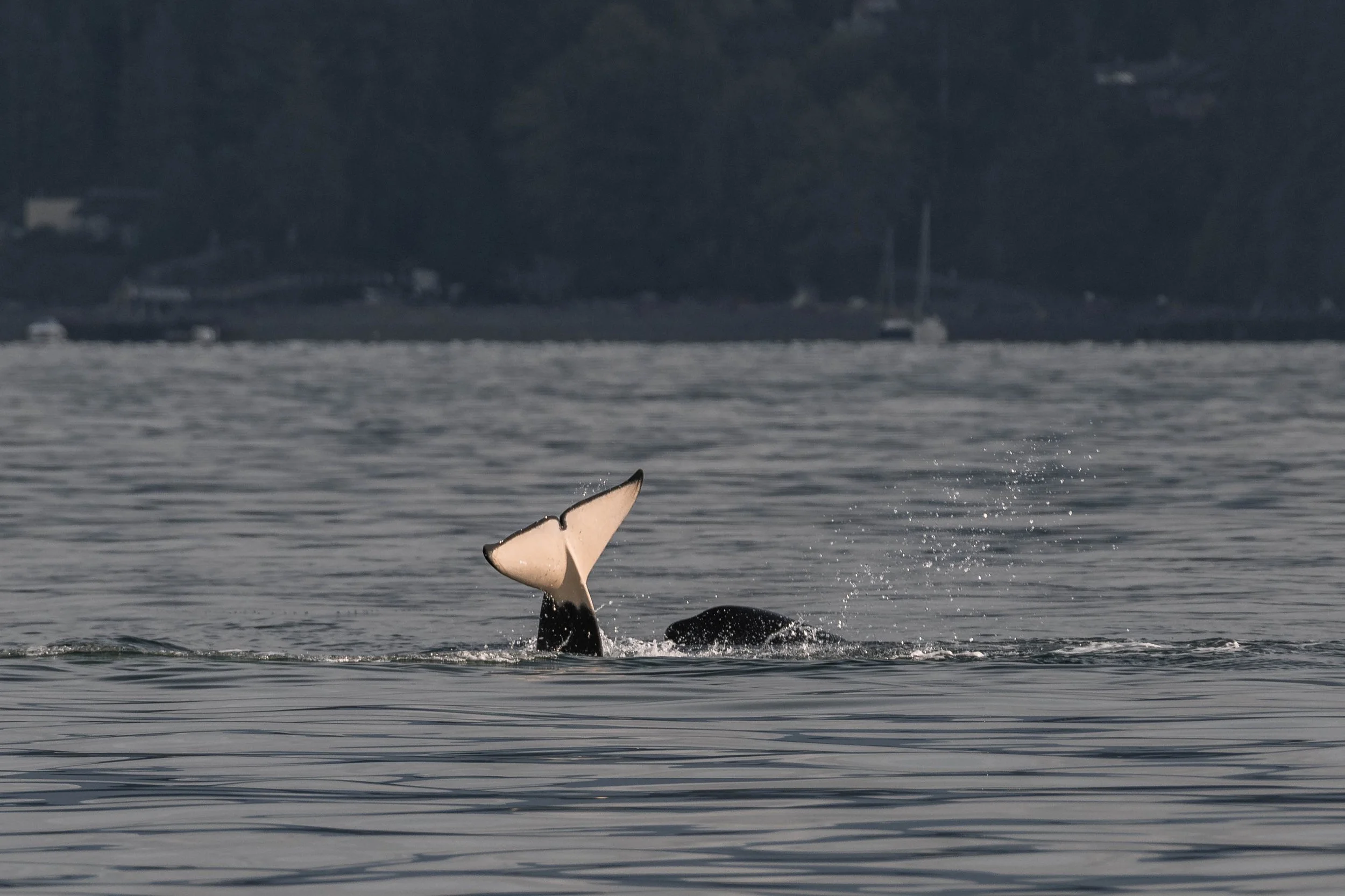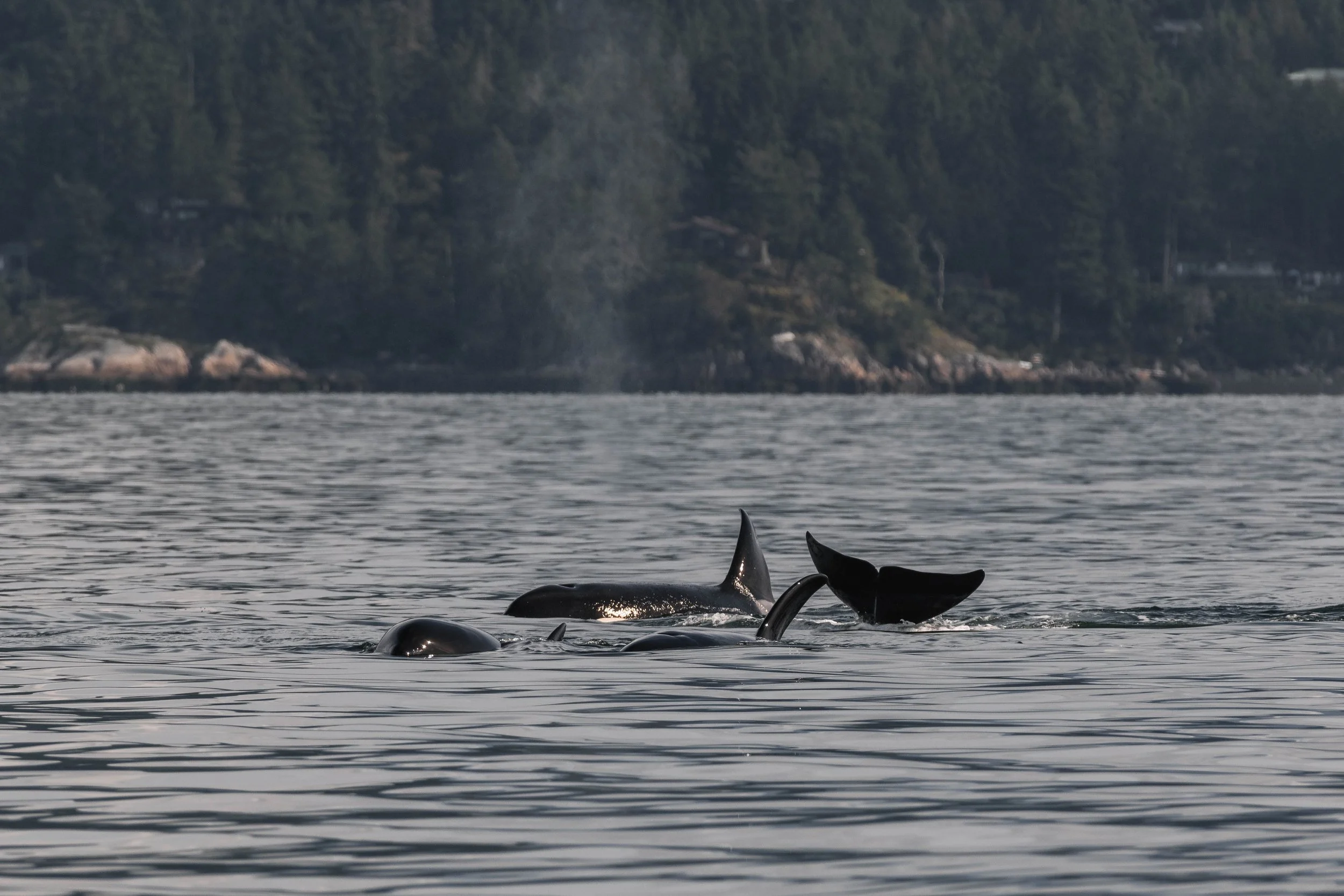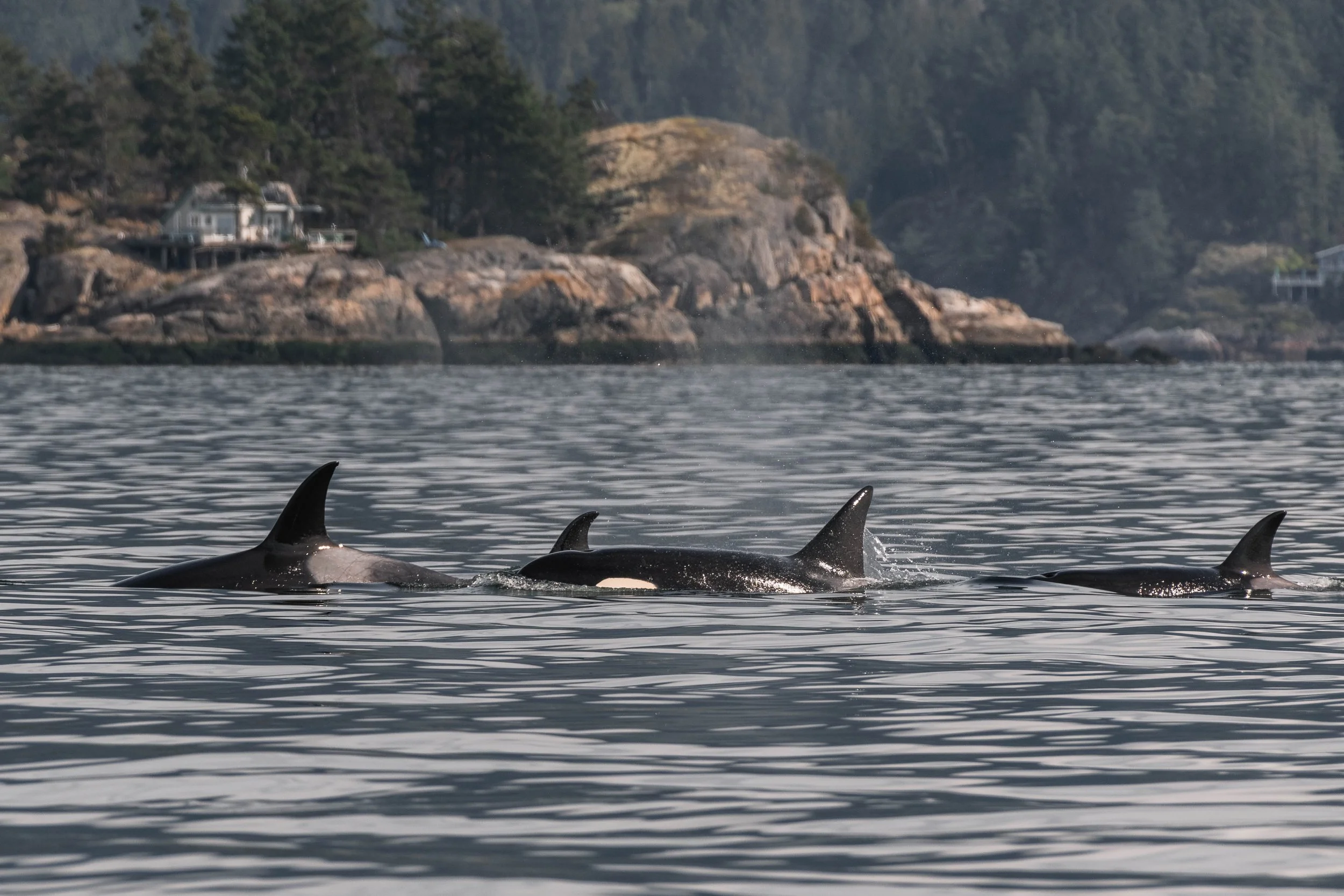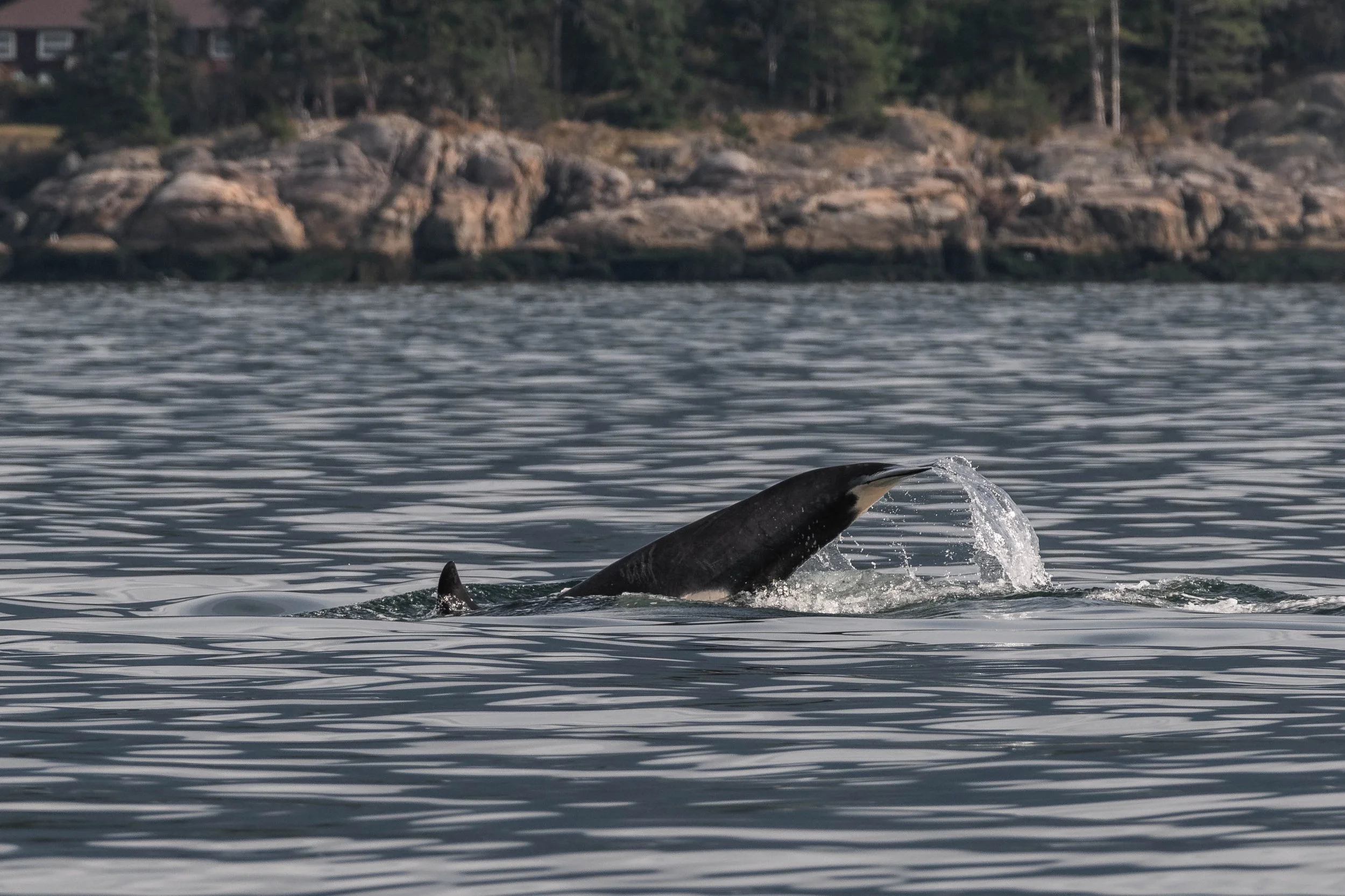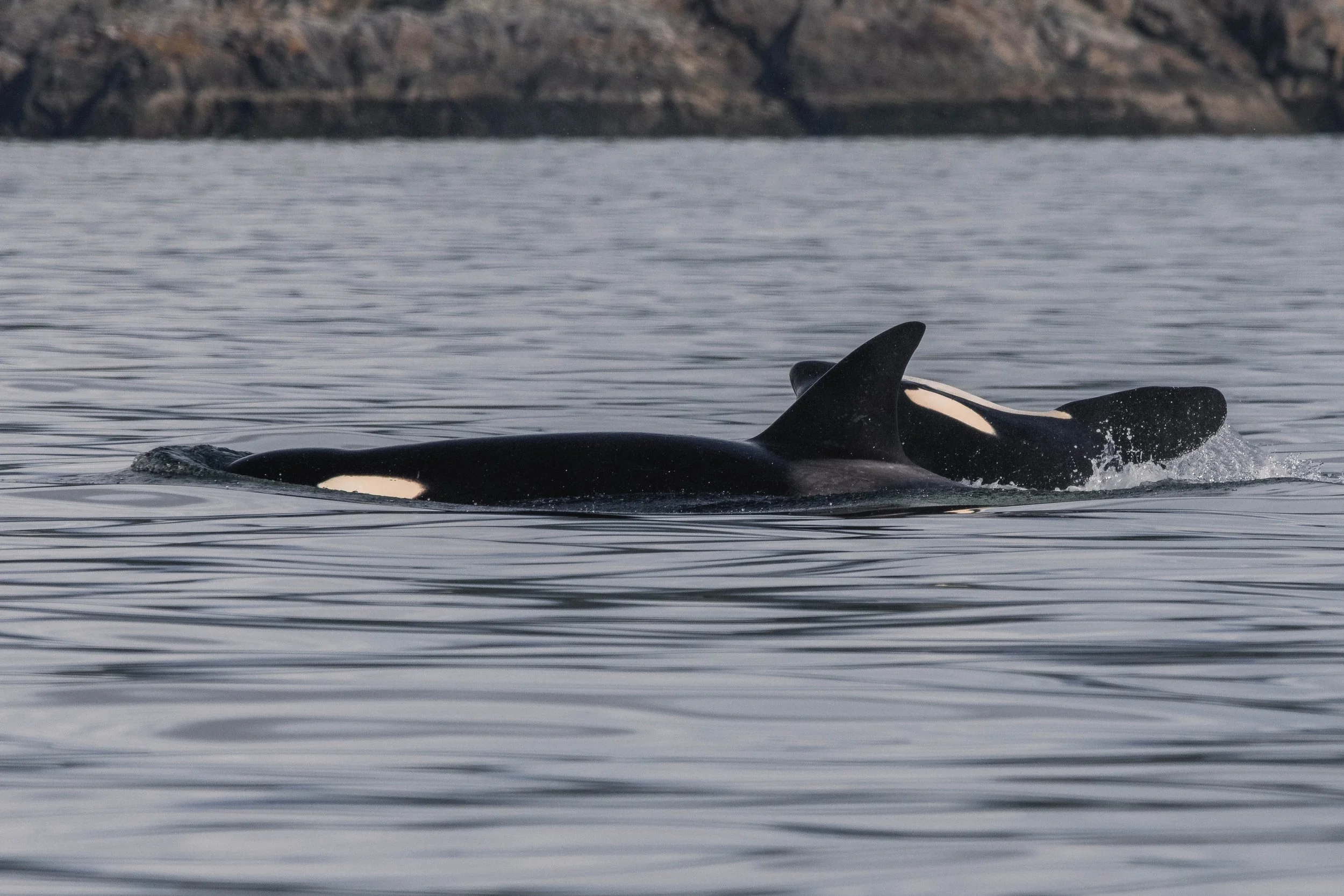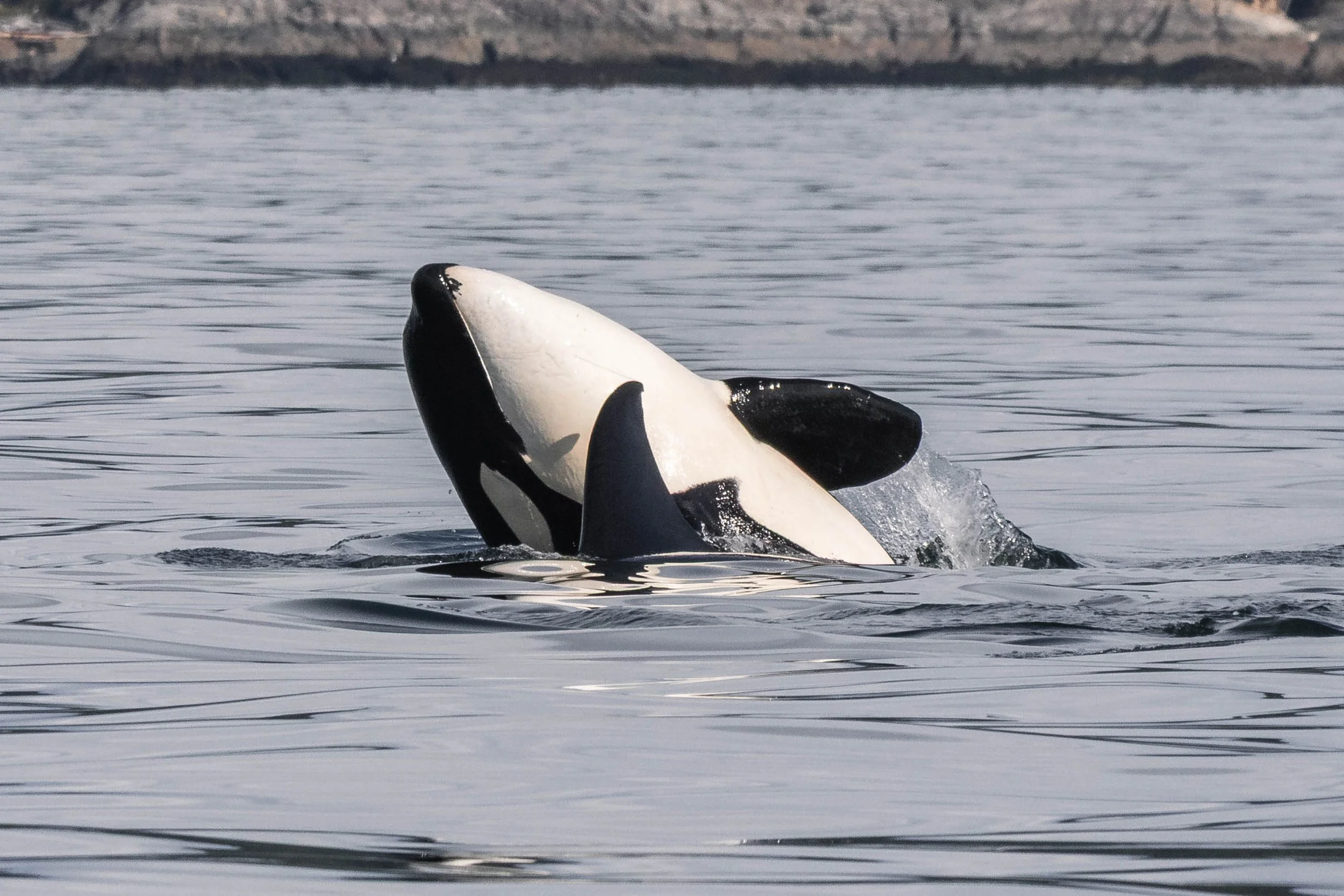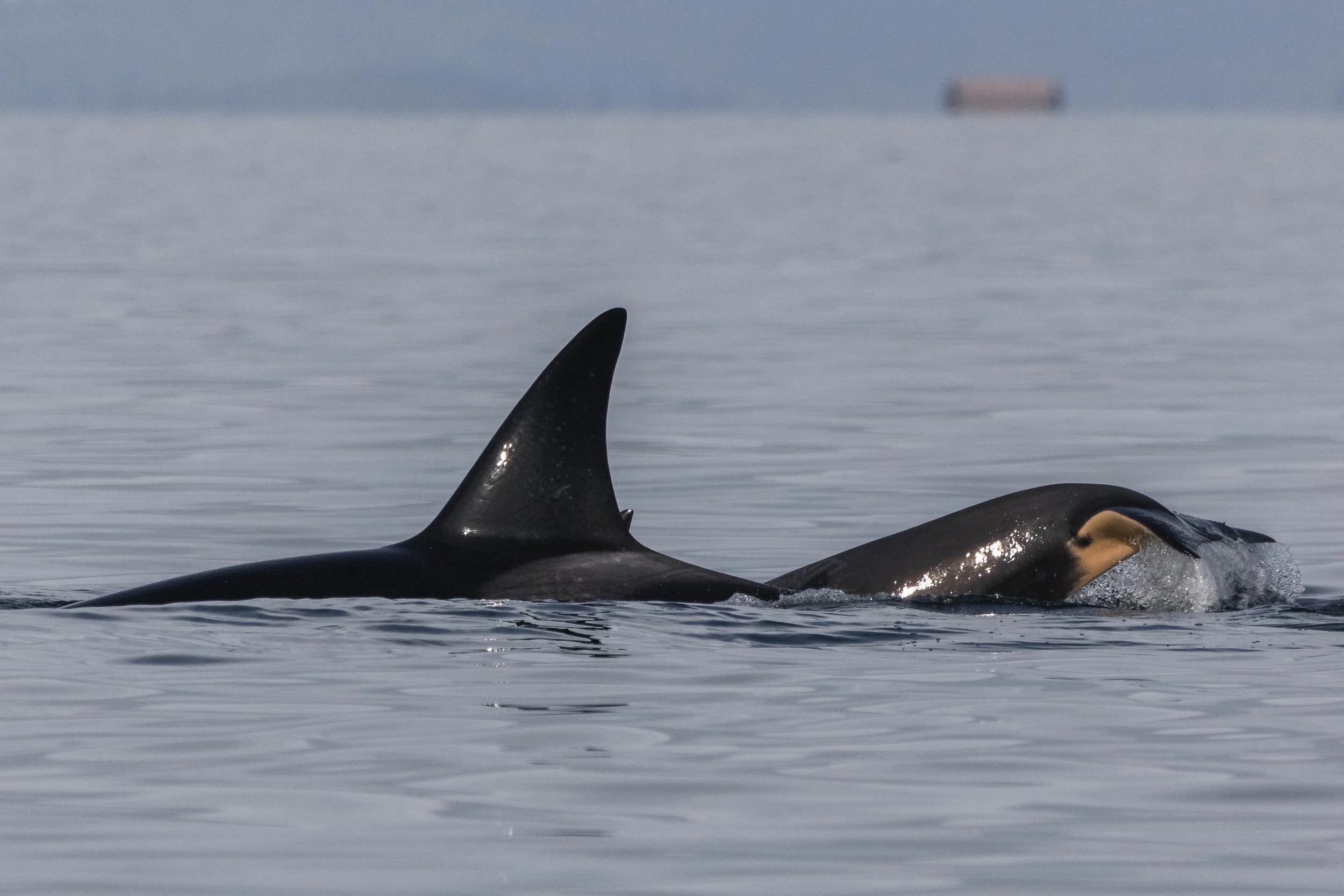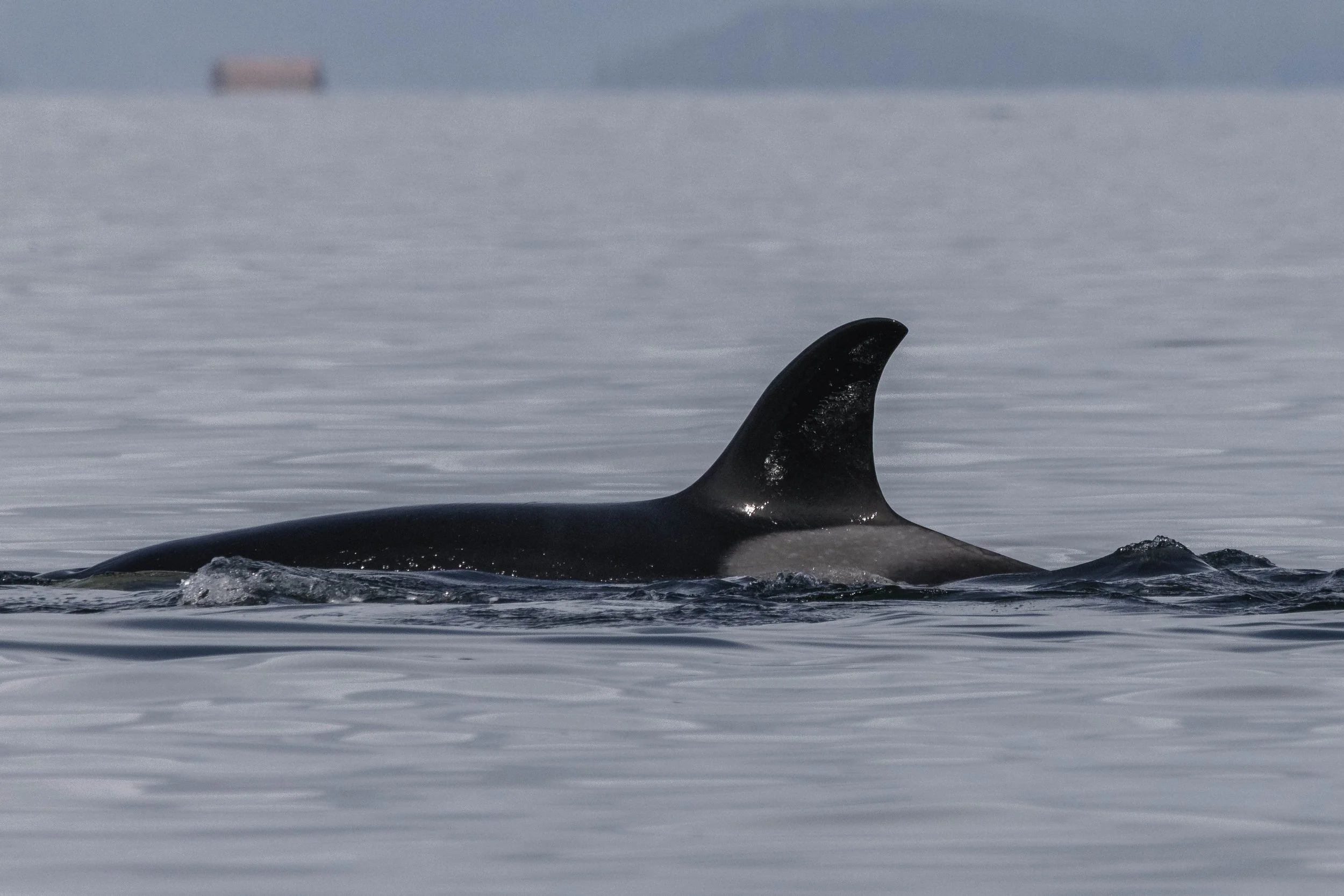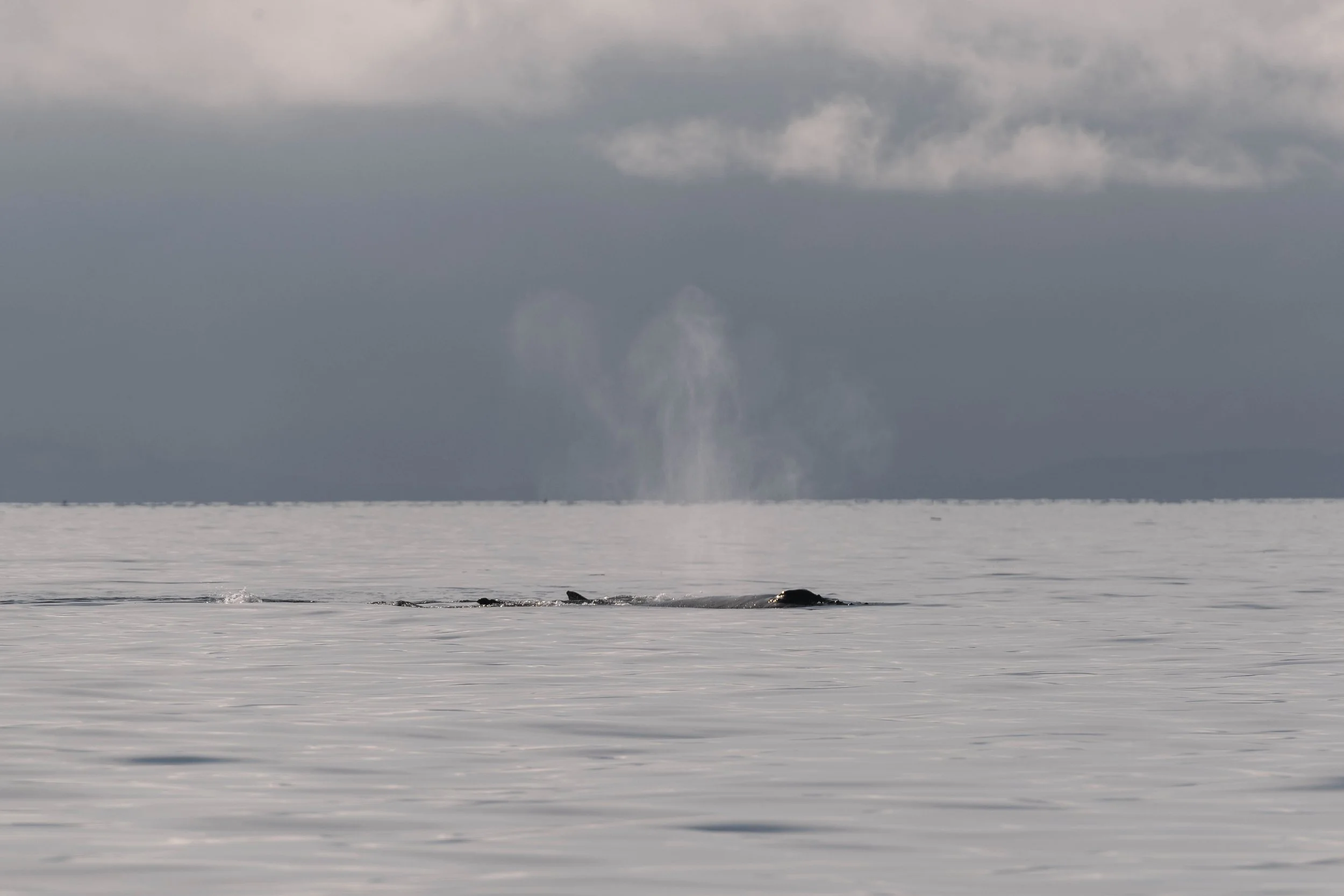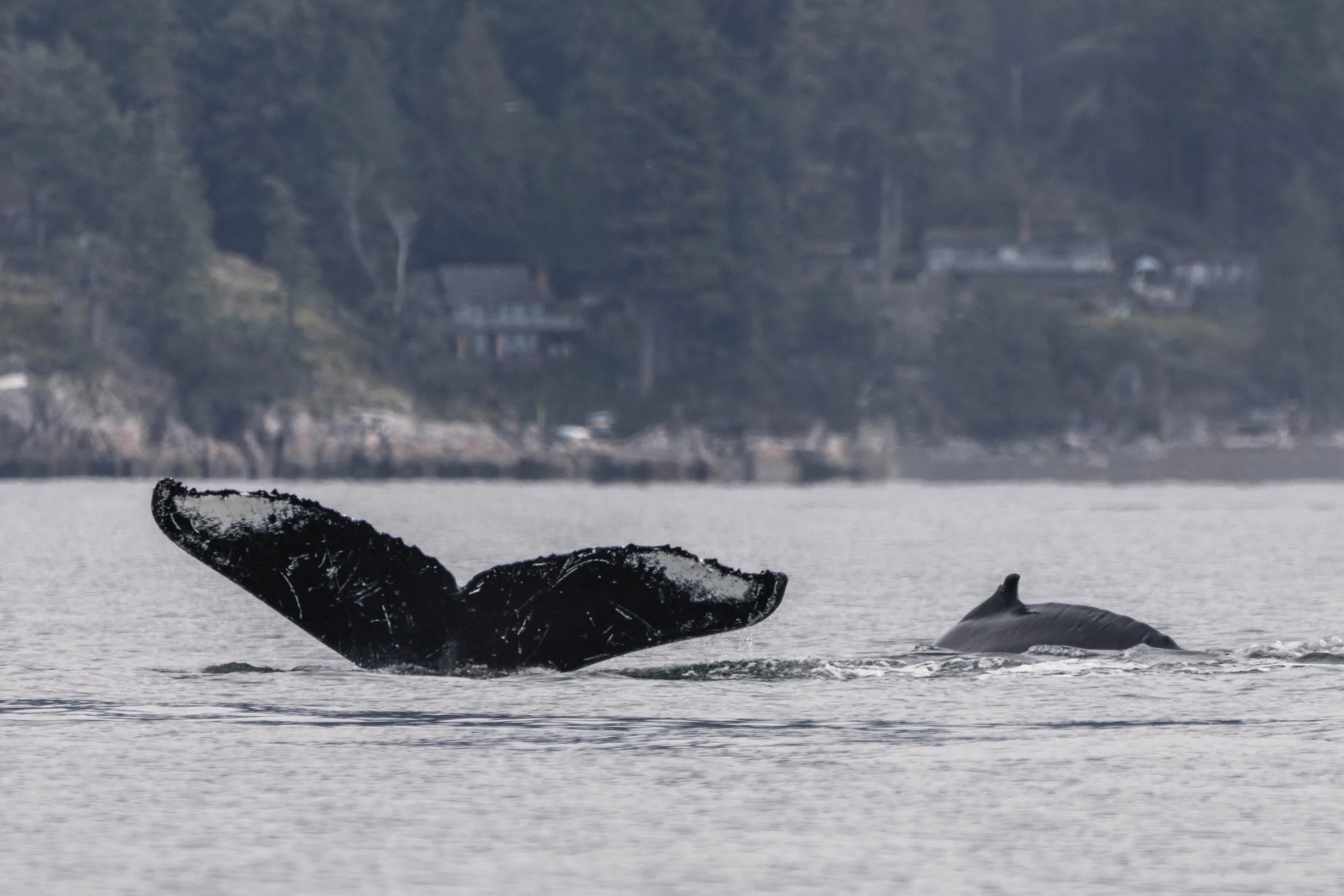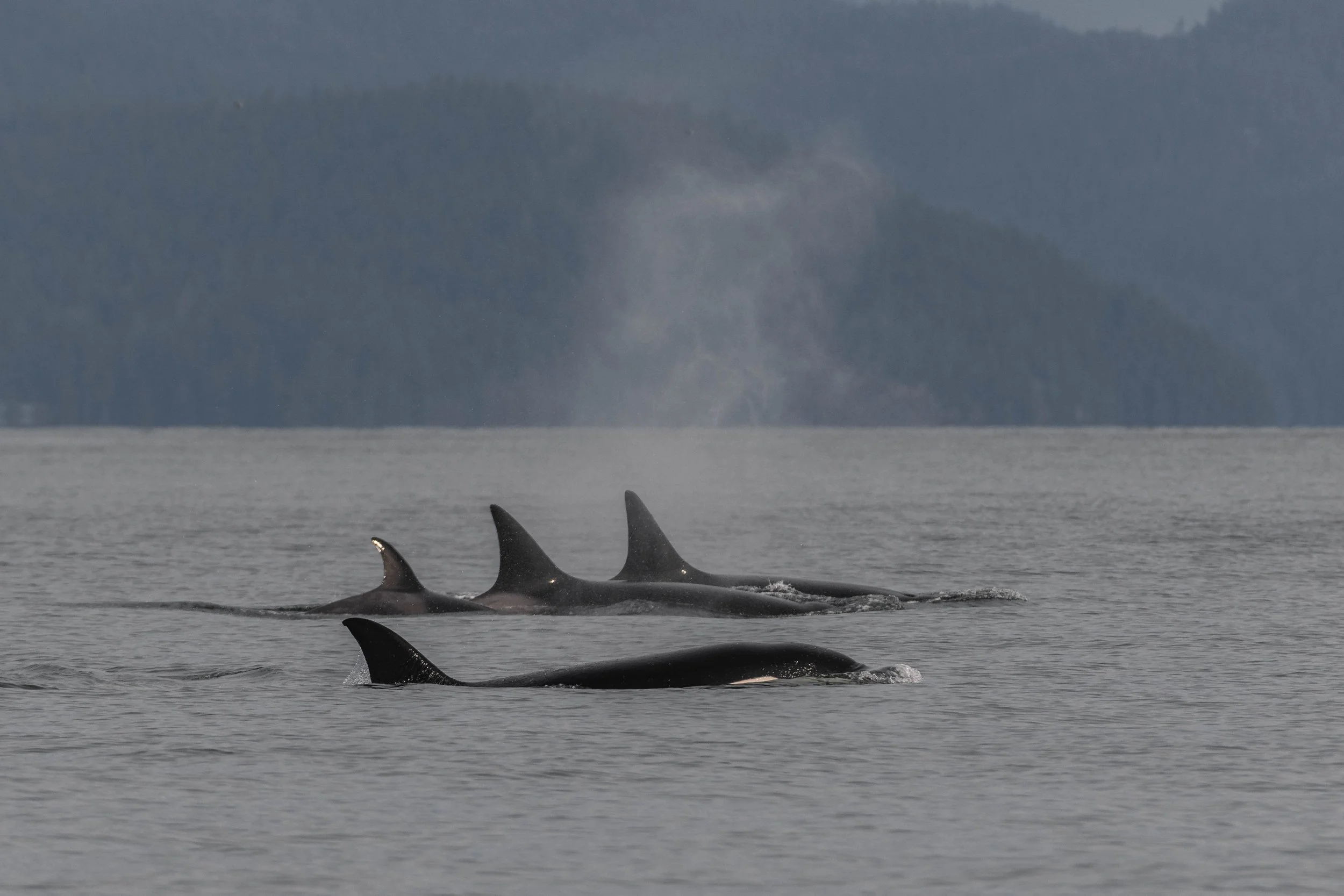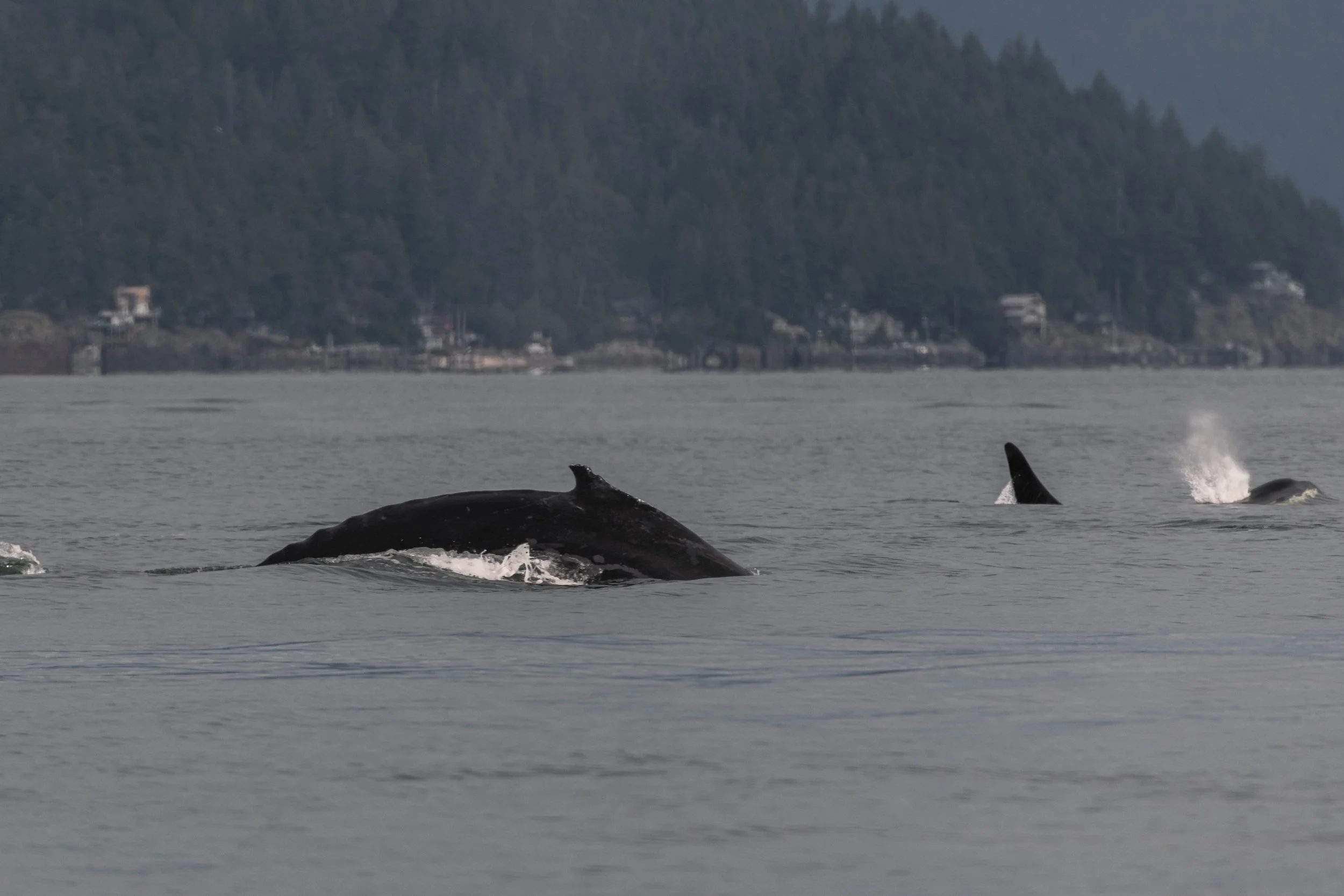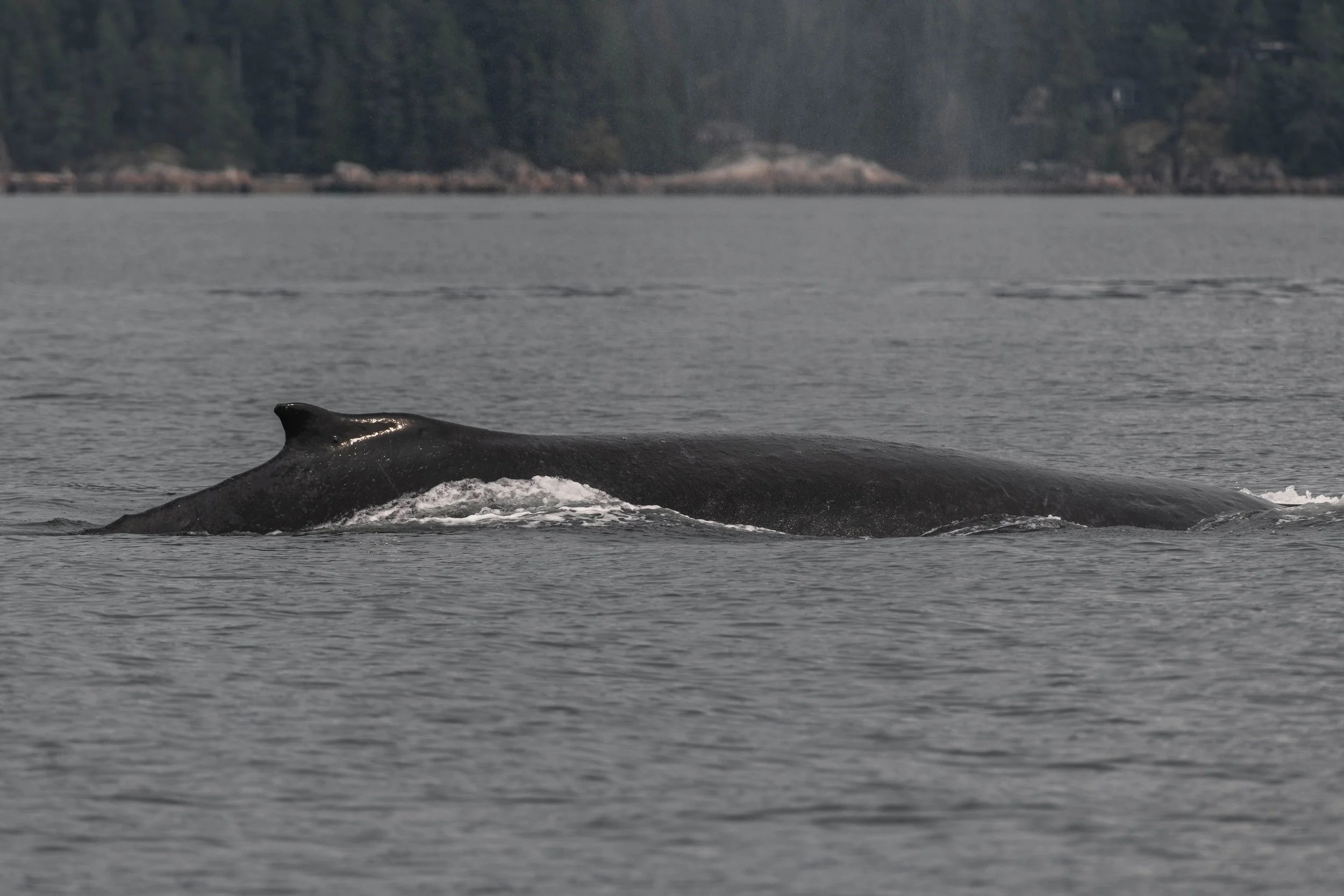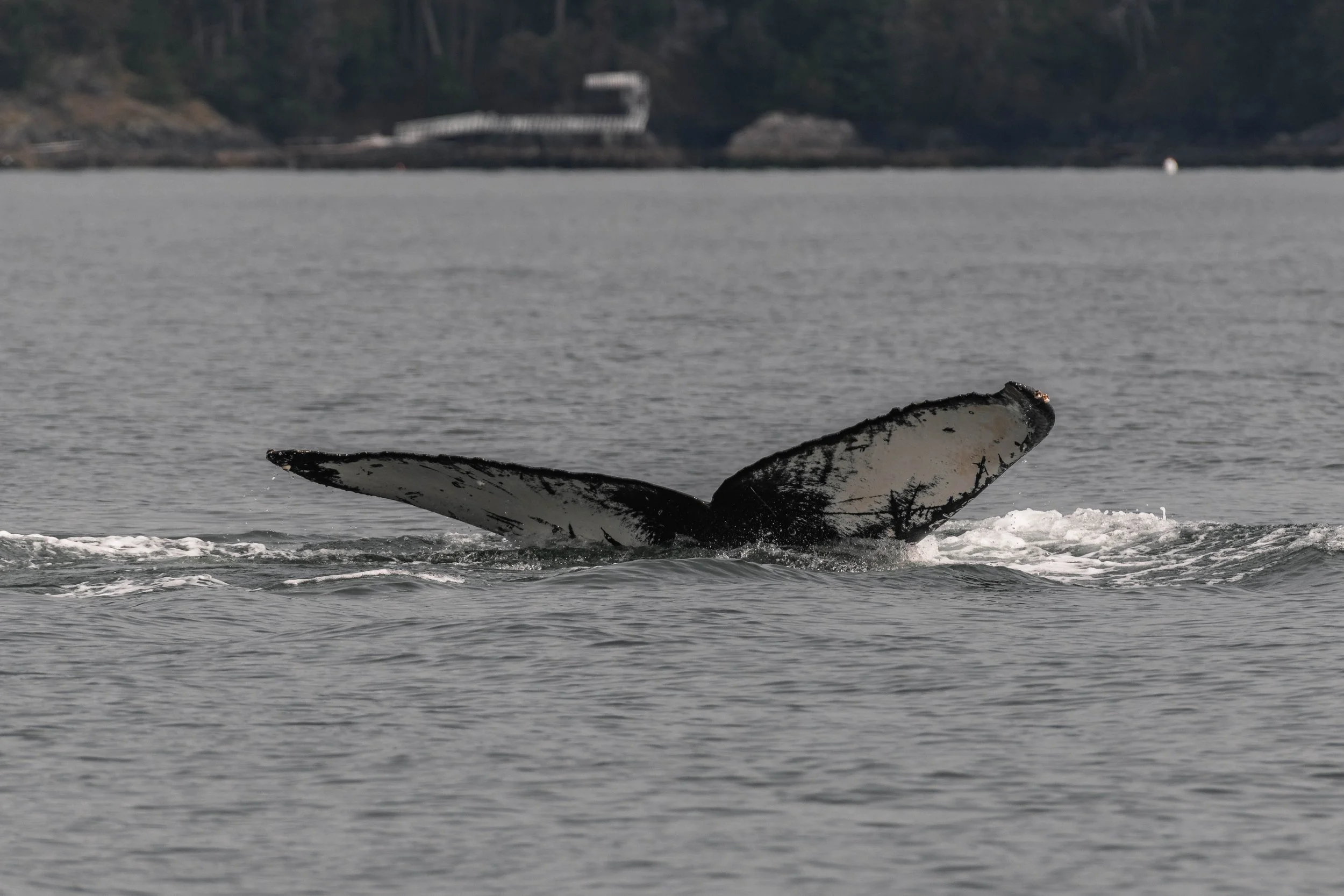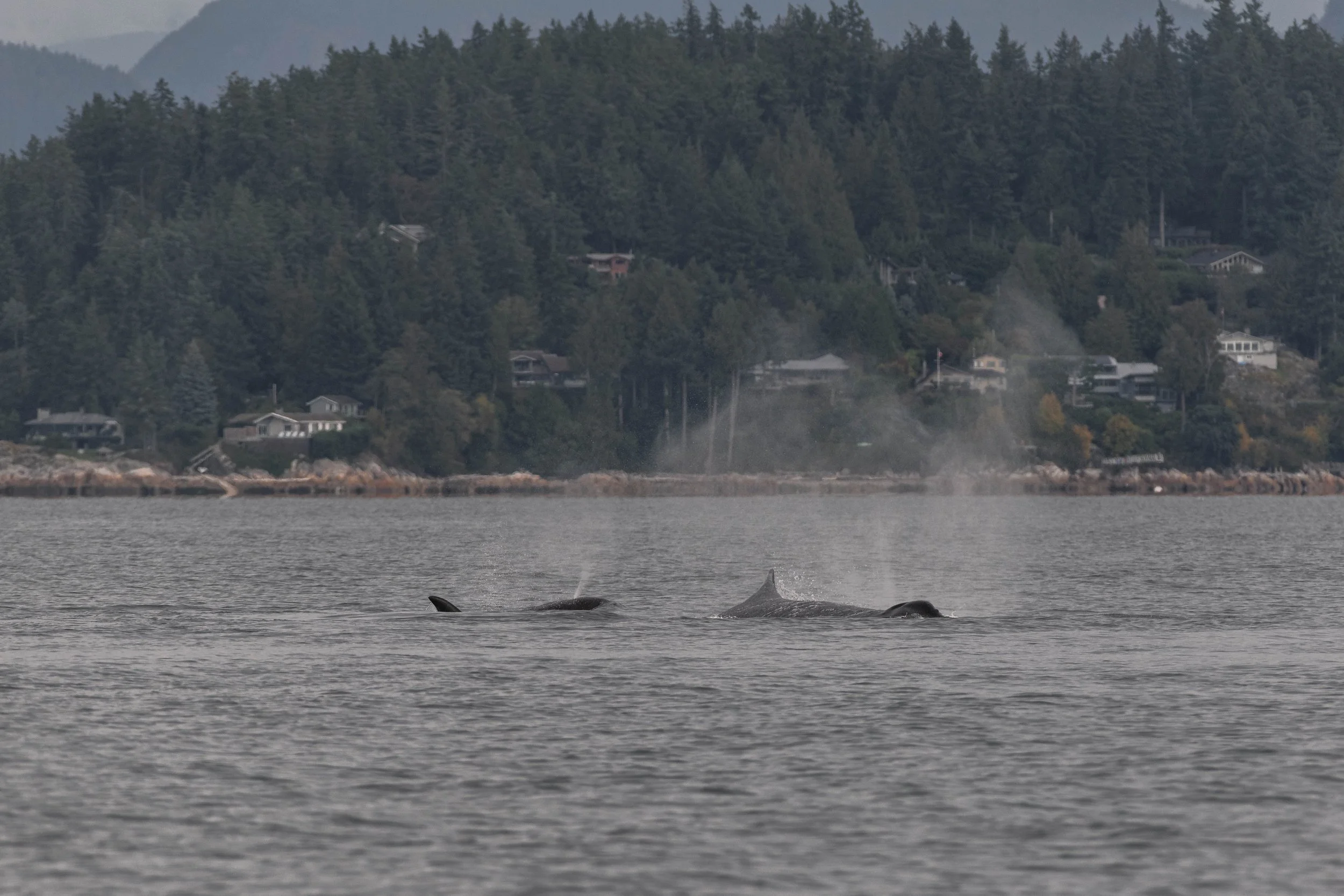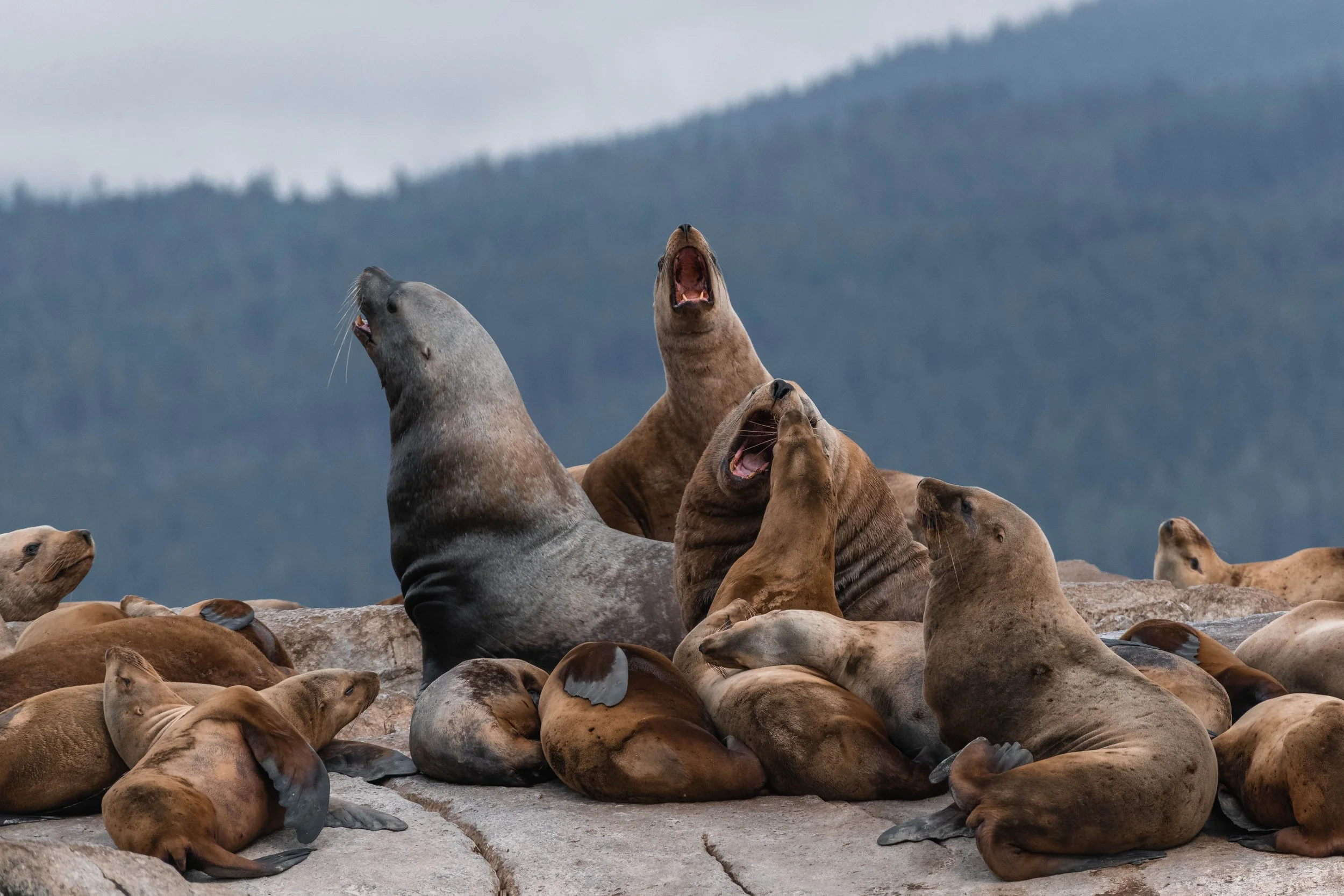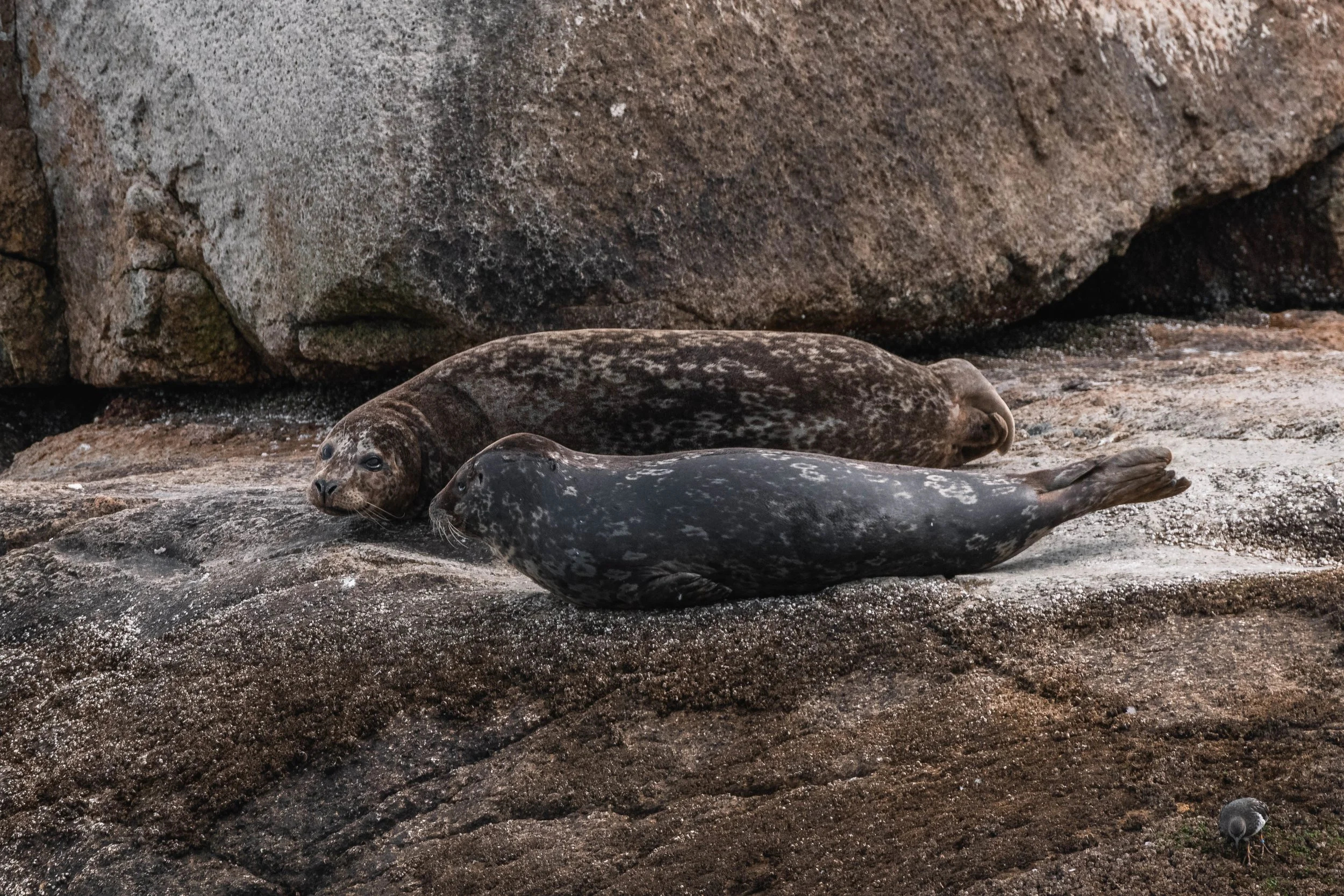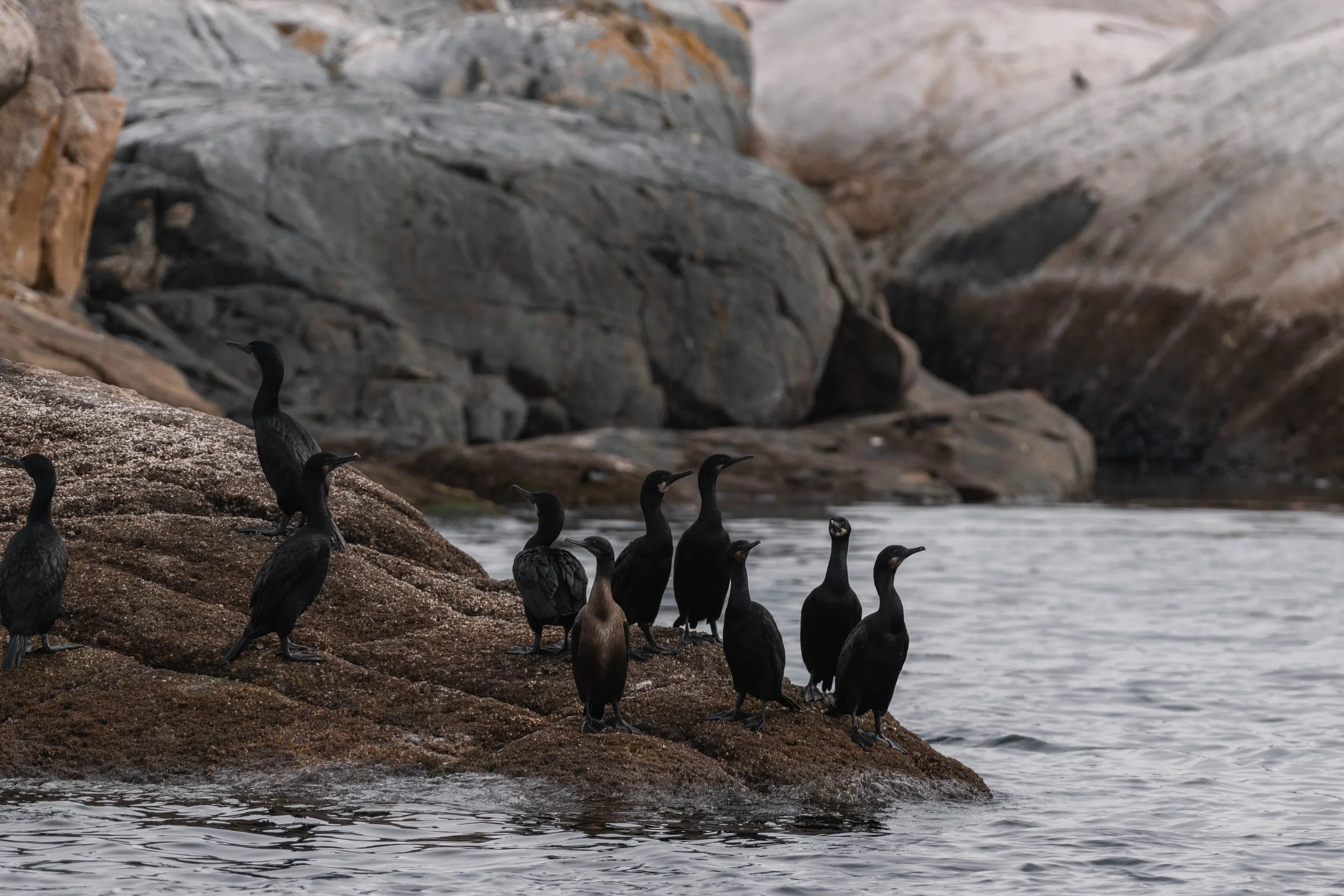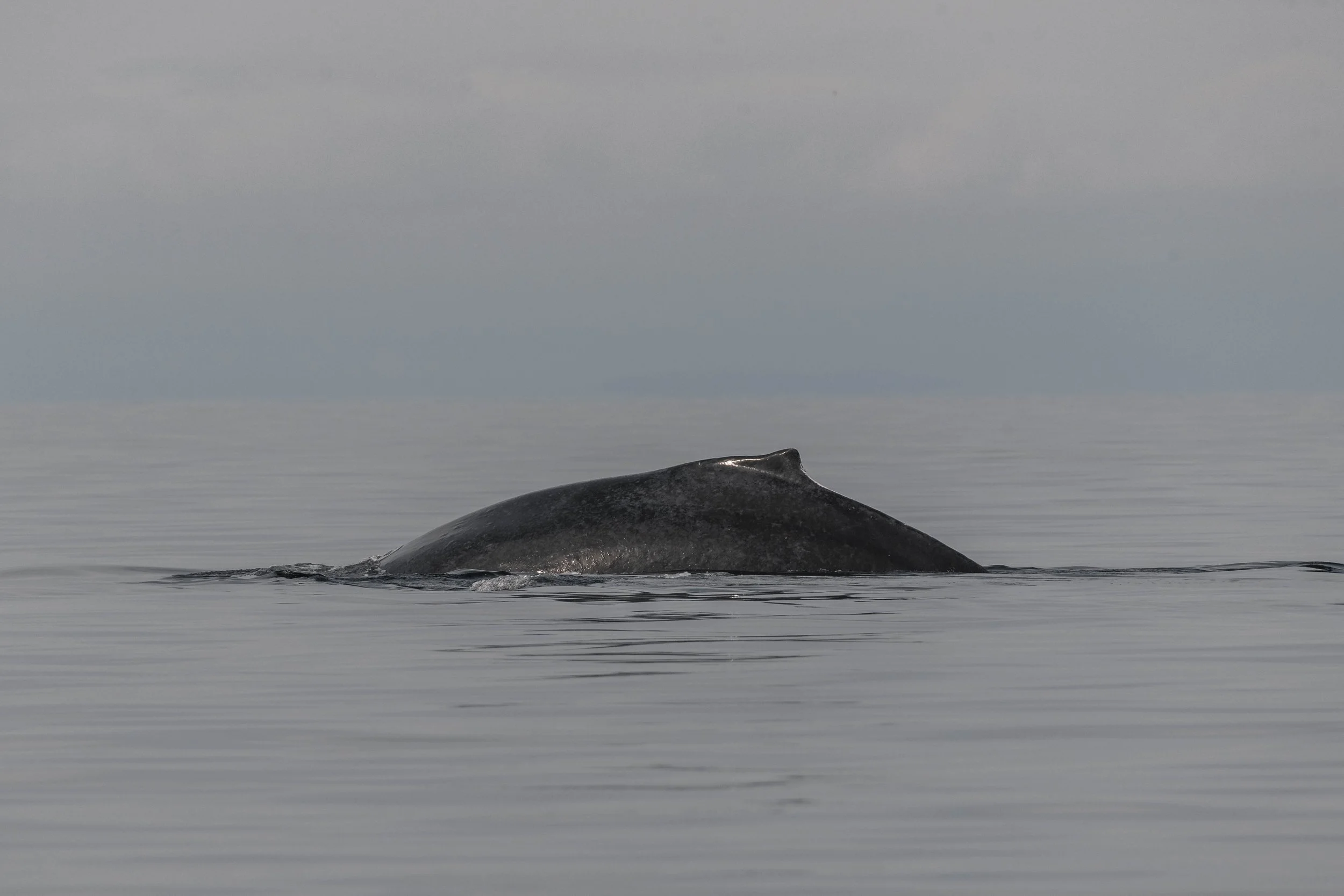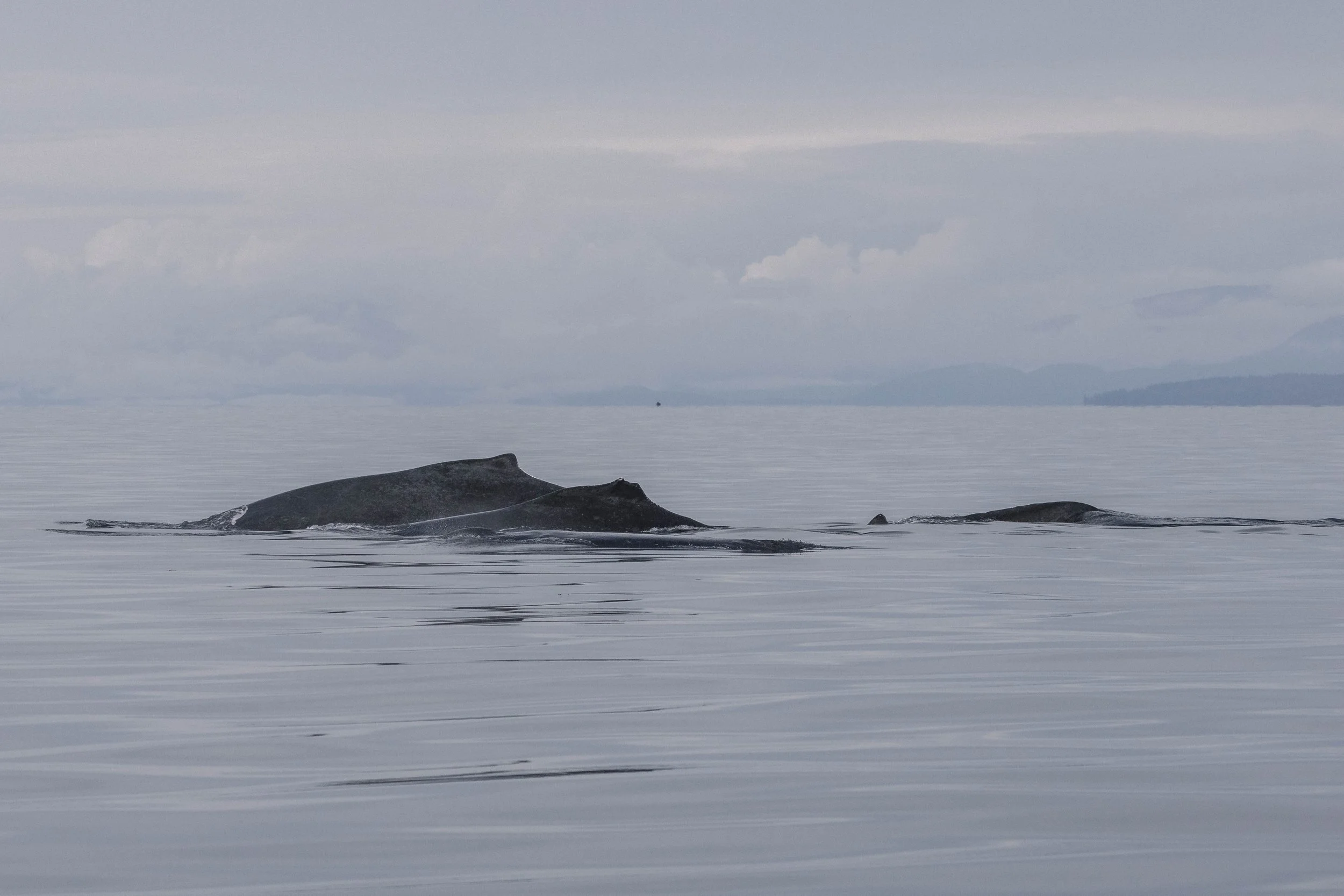October 3, 2025 - Clash of the Titans in the Salish Sea.
What began as a calm, glassy morning quickly turned into one of the most extraordinary encounters we’ve witnessed this season. With zero wind and a sea as smooth as polished stone, our two vessels set out from Nanaimo under clear skies, anticipation running high.
We set out northward, scanning the tranquil waters for signs of life. Despite the perfect viewing conditions, the ocean was quiet, no blows, no fins, just the occasional cry of a gull. Sometimes patience is key out here, but today it took us in a different direction.
Reports had come in of orca near Howe Sound, across the Strait of Georgia, so our captains decided to change course and make the crossing. As we cruised toward the mainland, the view of Vancouver’s skyline grew taller and sharper against the horizon. Then, mid-channel, something caught our eye, a few big, bushy blows rising from the calm sea ahead. Humpbacks!
It’s rare for us not to stop when we see a blow, after all, every encounter with these gentle giants is special, but today we had a destination in mind. Our captains marked the location carefully so we could return later. Little did we know, the whales we were about to meet next would shock us with their behaviour.
As we neared Howe Sound, dark, tall dorsal fins cut through the still water; we had found the orca. And not just any orca, this was what we call a T-party, a gathering where multiple Transient (or Bigg’s) orca pods join forces. These apex predators are the marine world’s social strategists, known for coordinating hunts and sharing food among family groups.
From the surface, we could see it was an active scene: spy hops, tail slaps, pectoral waves, and rolling, evident signs of play and social bonding. It was a joy to watch these powerful animals interacting with such energy and grace. The orca present were:
T124D Field ♀ (1996)
T124D1 Salish II (2014)
T124D3 (2022)
T124D4 (2024)
T035A Lester ♀ (1998)
T035A1 Opal ♀ (2010)
T035A2 Topaz ♂ (2013)
T035A3 Garnet (2018)
T035A4 ♂ (2022)
But as it turned out, not everyone nearby appreciated the orcas’ playful mood.
From the corner of our view, two massive figures began approaching, humpback whales, and they did not sound happy. As they drew closer, we could hear loud, trumpeting exhalations, a sound often associated with agitation or aggression. Suddenly, the humpbacks charged. It was Kata (BCY1218) and Orion (BCX1251).
This might seem surprising, after all, humpbacks are filter-feeding baleen whales, not predators. But there’s a deep history between these two species. Orca are one of the few known natural predators of humpbacks, particularly targeting calves or injured individuals. Adult humpbacks, however, are not easy prey. Weighing up to 40 tonnes, they are built for fight, not flight. They often use their massive tails, flippers, and sheer size to fend off attackers, or even to defend other species from orca hunts, a behaviour known as mobbing.
What unfolded next was nothing short of incredible.
The ocean around us seemed to boil as the two humpbacks squared off with the orca pods, trumpeting and swinging their enormous tails. Then, from the north, we saw more tall black fins slicing through the surface; the T101s had arrived, joining the original group and bringing the total number of orca to twelve.
T101 Reef ♀ (≤1969)
T101A Rush ♂ (1993)
T101B Lagoon ♂ (1997)
Now the odds were stacked heavily in favour of the orca, but before we could even process the imbalance, two more humpbacks surfaced in the distance! Callisto (BCX2486) and Prowler (BCX1660) were charging in for backup!
With the reinforcements, the sides were suddenly more even, four humpbacks against twelve orca. The sheer size difference was staggering: the largest male orca can reach about 27 feet in length, while an adult humpback can grow up to 50 feet, nearly twice as long and many times heavier. Yet orca are faster, more agile, and highly coordinated.
What followed was a breathtaking display of power and tension: tails swinging, sudden lunges, and the unmistakable sound of trumpeting blows echoing across the Strait. The humpbacks pressed their advantage, charging with bursts of speed, until finally, it seemed the orca had had enough. The pod began to disperse, heading south at least for now. As the commotion subsided, both species slowly drifted their separate ways.
Our day wasn’t over yet, though. On our way home, we made a stop at the White Islets, where the rocky shoreline was alive with sound and movement. The deep, guttural roars of Steller Sea Lions echoed across the water, males staking out their space and showing off their size, while others lazed in tangled piles along the sun-warmed rocks. A few curious individuals lifted their heads as our boats approached, letting out short grunts before flopping back down into the crowd.
Among them, harbour seals lounged quietly, their smaller, sleeker shapes dotting the lower ledges closer to the sea. These are the quieter residents of the islands, often resting between fishing trips or keeping a watchful eye out for the orca we’d seen earlier. Overhead, pelagic cormorants dried their wings in the breeze, while gulls circled, calling to one another as they searched for scraps left behind by the larger pinnipeds.
It’s always a treat to stop here, a reminder that the Salish Sea isn’t just home to whales, but a thriving community of marine life, each species playing a vital role in this coastal ecosystem. The sea lions and seals may seem like noisy neighbours, but their presence signals a healthy food web, sustained by the rich waters that flow through this unique inland sea.
And just when we thought the excitement was behind us, the calm surface of the Strait broke again, and four more humpbacks appeared ahead. It was Europa (BCX0854) and her calf, Crater/Mensa (BCX1565) and Wallace (KEX0014). This group was much more relaxed, moving slowly in a loose association, likely feeding. Watching them rise and fall through the calm sea, their blows catching the golden light, was a beautiful reminder of the gentler side of these giants.
After spending some quiet time with them, it was time to head back to the dock, hearts still racing from the day’s encounters.
The Salish Sea is full of surprises, moments of peace, bursts of power, and glimpses into the complex lives of the marine mammals that call it home. Today, we were lucky enough to witness all of it, from the quiet grace of humpbacks feeding to the raw energy of a clash between two of the ocean’s titans.
Photos below taken by Marine Naturalists Aly Kohlman and Vanessa Vereschahen.
Party photo! Photo by Vanessa Vereschahen.
Calf jumping in front of Lester and Topaz. Photo by Aly Kohlman.
Field with her youngest calf Dune. Photo by Aly Kohlman.
Dune poking their head out of the water behind mother Field. Photo by Aly Kohlman.
Did you know adult male orca have curver fluke fins? This is how we know that this orca is either a female or juvenile! Photo by Aly Kohlman
Pec slapping is a fantastic way to communicate with one another. Photo by Aly Kohlman.
Flukes up! Photo by Aly Kohlman.
Orcas sitting at the surface of the water. Photo by Aly Kohlman
Lester leading the way! Photo by Aly Kohlman.
A little tail slap. Photo by Aly Kohlman.
Lester, Field and Agate. Photo by Aly Kohlman.
Field in front and Opal in the back. Photo by Vanessa Vereschahen.
Garnet trying to get a piggy back ride from Salish II. Photo by Vanessa Vereschahen.
Garnet showing off their jumping skills. Photo by Vanessa Vereschahen.
Field is the matriarch of her small family. She currently has 3 surviving calves. Photo by Vanessa Vereschahen.
Water flying off the end of a tail fluke. Photo by Vanessa Vereschahen.
Big sister Salish II next to her tail slapping sibling. Photo by Vanessa Vereschahen.
Opal coming up for the breath! Photo by Vanessa Vereschahen.
Side stroke swimming. Photo by Vanessa Vereschahen.
Orion approching from a distance. Photo by Aly Kohlman.
Orion’s dorsal fin with Kata surfacing beside. Photo by Aly Kohlman.
Orion diving with Kata’s dorsal beside. Photo by Vanessa Vereschahen.
Lester in the foreground with Lupine, Field and Reef in the backgound. Photo by Aly Kohlman.
Field being chased by a humpback. Photo by Aly Kohlman.
Kata chasing Rush. Photo by Aly Kohlman.
Orion’s dorsal fin. Photo by Aly Kohlman.
A fluke waterfall from Orion. Photo by Aly Kohlman.
Kata fluking. Photo by Aly Kohlman.
Orion in the lead, Prowler in the middle and Kata surfacing alongside. Photo by Aly Kohlman.
It’s not everyday we get orca and humpback in the same photo! Photo by Aly Kohlman.
Humpback on the left orca on the right! Photo by Aly Kohlman.
Can you spot the orca dorsal behind the blow? Photo by Aly Kohlman.
Opal getting dangerously close to a humpback fluke.Photo by Aly Kohlman.
Topaz and Garnet chasing Prowler. Photo by Aly Kohlman.
Because Rush is an adult male, his dorsal fin is around 6 feet tall. Photo by Aly Kohlman.
Steller Sea Lions growling from the White Islets. Photo by Aly Kohlman.
A Steller snoozing. Photo by Vanessa Vereschahen.
Chubby harbour seals resting on the rocks. Photo by Aly Kohlman.
Look how well this seal blends in with the rocks. Photo by Vanessa Vereschahen.
Cormorants at the White Islets. Photo by Aly Kohlman.
A bald eagle perched on the rocks. Photo by Vanessa Vereschahen.
Europa’s dorsal fin. Photo by Aly Kohlman.
Europa in the lead with Crater in the middle as Wallace just breaks the surface and Europa’s calf following. Photo by Vanessa Vereschahen.
A rostrum poking above the surface. Photo by Vanessa Vereschahen.
Wallace in the lead with Crater behind. Photo by Vanessa Vereschahen.
Wallace, can you see their scars? Photo by Vanessa Vereschahen.
Crater fluking as Europa surfaces. Photo by Vanessa Vereschahen.



